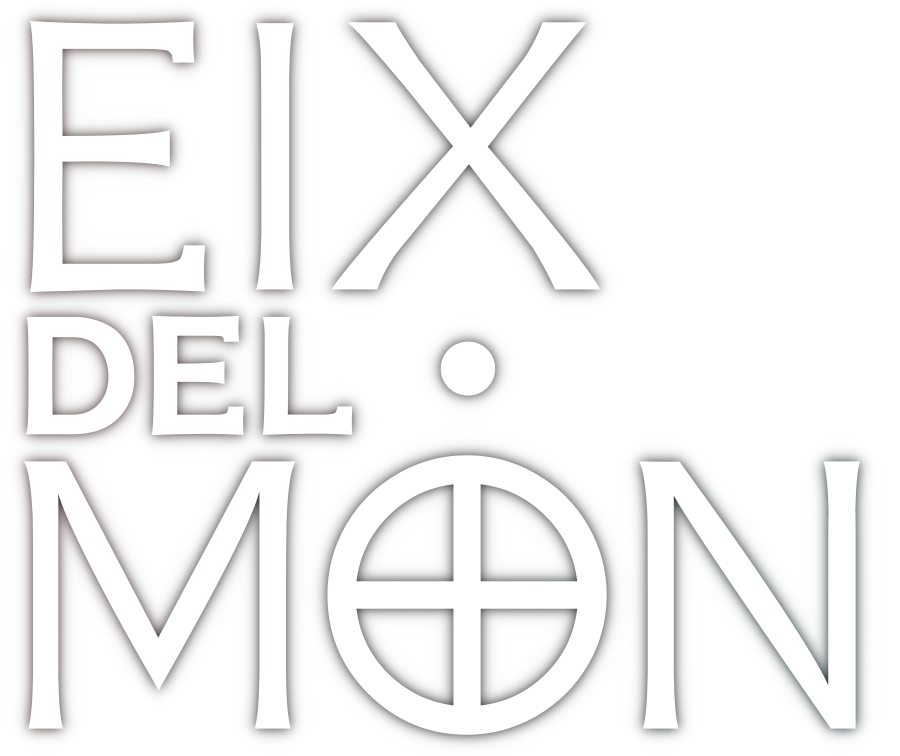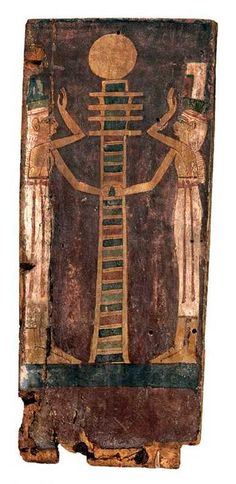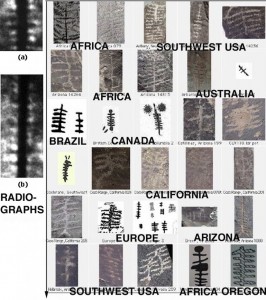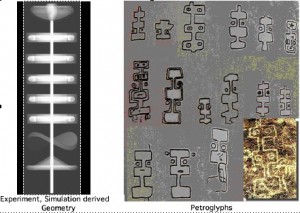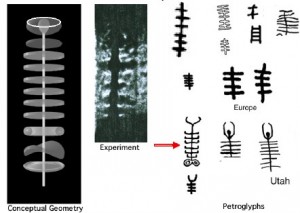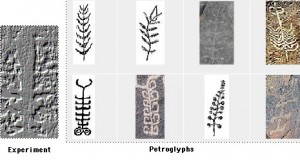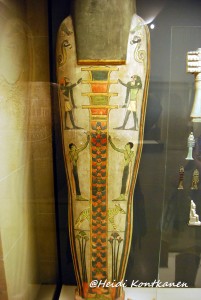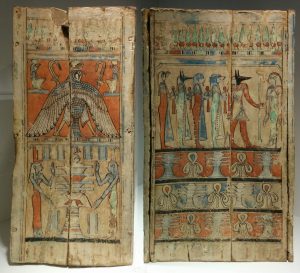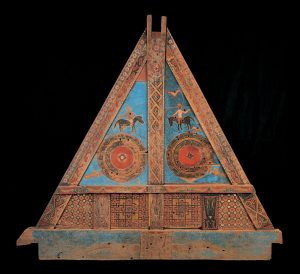Djed Pillar. Fragment of an Antropoid Inner Coffin.
| Present location | ALLARD PIERSON MUSEUM [06/002] AMSTERDAM |
|---|---|
| Inventory number | APM08103 |
| Dating | 21st Dynasty |
| Archaeological Site | Unknown |
| Category | COFFIN/SARCOPHAGUS OF HUMANS |
| Material | WOOD; PLASTER |
| Technique | PAINTED ON STUCCO |
| Height | 28.8 cm |
| Width | 66 cm |
| Depth | 4.8 cm |
The original inventory item can be found at Universiteit van Amsterdam website. Global Egyptian Museum website states:
The object is a fragment of an anthropoid inner coffin. […] Isis and Nephthys bewail a multicoloured Djed-pillar, crowned with a sun-disk.
Isis and Nephthys resemble supporters.
Because the artifact is dated as belonging to the 21st dynasty, I’ll tentatively put it in Tanis, the capital of such dynasty.
Britannica says:
In 1939 several intact royal tombs of the 21st and 22nd dynasties were excavated in the main temple enclosure in Tanis. Silver coffins, gold masks, and jewelry in gold and silver recall the burial of Tutankhamen, though they are not as rich. Moreover, the tombs and even the sarcophagi were reused material from earlier periods. In 2009 a sacred lake measuring 50 by 40 feet (15 by 12 metres) and dedicated to the goddess Mut was found at Tanis.
The Djed-pillar
The Djed pillar appears in the myth of Isis and Osiris. Set killed Osiris by tricking him into a coffin. The coffin was then flung into the Nile and carried into the ocean. A sacred tree grew around it, enclosing the coffin within its trunk. The king of the land ordered the tree cut down and installed as a pillar in his palace. Later Isis extracted Osiris from the pillar and consecrated it. The Book of the Dead explains that the djed-pillar is the backbone of Osiris. It became the symbol of endurance or stability.
See page 124 of the following book for an extended explanation of the origin of the symbol (called there Ṭeṭ) and many other Egyptian myths:
-
![[PDF]](https://www.eixdelmon.com/wp-content/plugins/papercite/img/pdf.png) S. Budge E. A. Wallis, The gods of the Egyptians; or, Studies in Egyptian mythology, Chicago : Open Court Publishing Co., 1904.
S. Budge E. A. Wallis, The gods of the Egyptians; or, Studies in Egyptian mythology, Chicago : Open Court Publishing Co., 1904.
[Bibtex]@Book{godsofegyptianso02budg, Title = {The gods of the Egyptians; or, Studies in Egyptian mythology}, Author = {{Budge}, E. A. Wallis, Sir}, Publisher = {Chicago : Open Court Publishing Co.}, Year = {1904}, Note = {Published: 1904 Topics: Mythology, Egyptian, Egypt -- Religion Identifier: godsofegyptianso02budg Mediatype: texts Copyright-evidence-operator: Steven F Radzikowski Copyright-region: US Copyright-evidence Evidence: reported by Steven F Radzikowski for item godsofegyptianso02budg on September 16, 2008: no visible notice of copyright; stated date is 1911. Copyright-evidence-date: 20080916115858 Scanningcenter: nj Ppi: 400 Camera: Canon 5D Operator: scanner-joe-ondreicka@... Scanner: scribe4.nj.archive.org Scandate: 20091016154550 Imagecount: 560 Foldoutcount: 1 Identifier-access: http://www.archive.org/details/godsofegyptianso02budg Identifier-ark: ark:/13960/t9280jp07 Sponsordate: 20080930 Bookplateleaf: 0003 Ocr: ABBYY FineReader 8.0}, File = {godsofegyptianso02budg.pdf:godsofegyptianso02budg.pdf:PDF}, Keywords = {Mythology, Egyptian, Egypt -- Religion}, Owner = {trismegisto}, Timestamp = {2016.01.06}, Url = {https://archive.org/details/godsofegyptianso02budg} }
Let’s remember some of the plasma column instabilities:
Let’s see other Djed pillars (and similar things from elsewhere):
